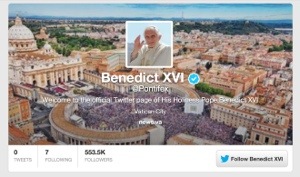 Pontifex means “bridge builder” In Latin, so it should come as no surprise that this is what the pope chose for his Twitter handle.
Pontifex means “bridge builder” In Latin, so it should come as no surprise that this is what the pope chose for his Twitter handle.
So far, @Pontifex is gaining a veritable avalanche of followers, yet the account only follows seven. Since those seven are mirrors of the @Pontifex account in different languages, they don’t really count. This has not stopped a wide array of people, from the snarky to the devout, flocking to follow as they wait for the Pope’s first tweet. Over 200,000 followed Pope Benedict’s account within hours of its creation, with the numbers topping half a million by the following Tuesday.
The FaithWorld blog on Reuters gives us some more details about the account and who will actually be penning the tweets:
The tweets will come primarily from the contents of his weekly general audience, Sunday blessings and homilies on major Church holidays. They will also include reaction to major world events, such as natural disasters.
He will push the button on his first tweet himself on Dec. 12 but in the future most of the tweets will be written by aides, and he will sign off on them.
The Vatican, whose website has been taken down by hackers in the past, said it has taken precautions to make sure the pope’s certified account is not hacked. Only one computer in the Vatican’s Secretariat of State will be used for the tweets.
It seems that while the platform is social, the uses it will be put to are slated to be more broadcast-oriented. Of course, this is not surprising if you look at some of the other religious leaders on Twitter, as far more of them use modern tools this way rather than risk the unexpected circumstances that can come with unfiltered, direct engagement. The Dalai Lama, for example, has over five and a half million followers yet follows no one.
Elizabeth Drescher, a writer for Religion Dispatches, notes that this broadcast stance blurs an important line — the one between ministry and marketing:
Certainly, the active participation of corporate religious outreach specialists like Twitter’s Ortiz begs the question of what the aggregation of mostly faith-motivated followers (along with a small but lively measure of critics and trolls) around a figure like Pope Benedict offers Twitter from a data-mining and advertising sales perspective. Do religious organizations and their leadership have any obligation to avoid offering up their flock as a conveniently aggregated demographic block?
Beyond this, does the development of massive follower bases on social media sites really amount to the kind of ‘connection’ and ‘engagement’ — these being chief among the values Ortiz and Tighe suggest the Pope’s Twitter participation offers — that are at the heart of genuine ministries?
[Boston-based Lutheran pastor and blogger] Keith Anderson and I have argued that the sorts of digital broadcast messaging projects such as those being undertaken by the Vatican and by other world religious leaders do not, in fact, constitute ministries in that, while they provide broad access to information in a Web 1.0 way, they do not invite the kinds of Web 2.0+ interpersonal engagement that have the potential to extend from digital to local spaces.
It is easy to understand the Vatican’s hesitancy to embrace a truly social stance. They are unsurprisingly gun-shy of online efforts in the wake of being hacked. Combine that with some of the viral Twitter failures that have been in the news these past few years, and their trepidation does make a certain amount of sense. Still, by passing up the risk they are also passing up huge potential to motivate their faithful.
When the digital pulpit will produce its first tweet on December 12, will you be following? What do you think of the pope joining Twitter? What about the way it will be used? Let us know in the comments, we are eager to hear your thoughts!